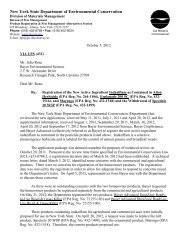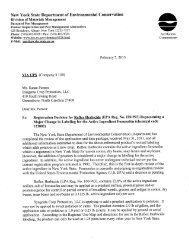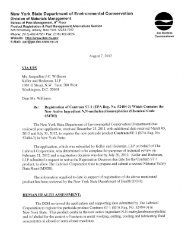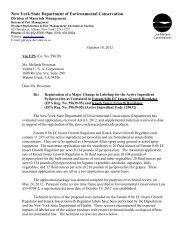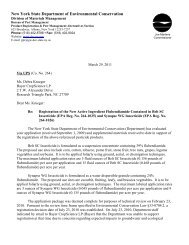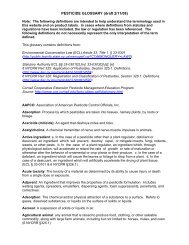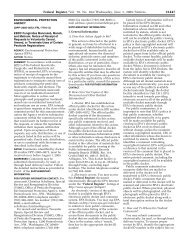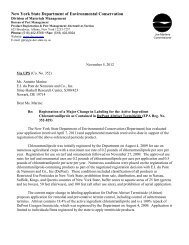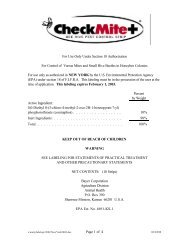Mesotrione - Registration of a Major Change in ... - Cornell University
Mesotrione - Registration of a Major Change in ... - Cornell University
Mesotrione - Registration of a Major Change in ... - Cornell University
Create successful ePaper yourself
Turn your PDF publications into a flip-book with our unique Google optimized e-Paper software.
New York State Department <strong>of</strong> Environmental Conservation<br />
Division <strong>of</strong> Solid and Hazardous Materials<br />
Bureau <strong>of</strong> Pesticides Management, 11 th Floor<br />
625 Broadway, Albany, New York 12233-7257<br />
Phone: (518) 402-8768 • Fax: (518) 402-9024<br />
Website: www.dec.ny.gov/chemical/298.html<br />
E-mail: ppr@gw.dec.state.ny.us<br />
CERTIFIED MAIL (Co. No. 100)<br />
Ms. Susan Person<br />
Syngenta Crop Protection, Inc.<br />
P.O. Box 18300<br />
Greensboro, NC 27419-8300<br />
Dear Ms. Person:<br />
February 3, 2010<br />
Alexander B. Grannis<br />
Commissioner<br />
Re: <strong>Registration</strong> <strong>of</strong> a <strong>Major</strong> <strong>Change</strong> <strong>in</strong> Labeled (MCL) Use Pattern for the Active Ingredient<br />
<strong>Mesotrione</strong> Conta<strong>in</strong>ed <strong>in</strong> the Pesticide Product Tenacity (EPA Reg. No. 100-1267;<br />
Chemical Code 122990)<br />
The New York State Department <strong>of</strong> Environmental Conservation (Department) has completed<br />
review <strong>of</strong> your application and data package received on July 15, 2008 regard<strong>in</strong>g registration <strong>of</strong> the<br />
above-referenced pesticide product. The subject application and data package were deemed complete<br />
for purposes <strong>of</strong> technical review on September 8, 2009. Pursuant to the review time frame specified <strong>in</strong><br />
Environmental Conservation Law (ECL) §33-0704.2, a registration decision date <strong>of</strong> February 5, 2010<br />
was established.<br />
Tenacity conta<strong>in</strong>s 40.0% <strong>of</strong> the active <strong>in</strong>gredient mesotrione (Chemical Code 122990) and is<br />
labeled as a preemergence and post-emergence herbicide for the selective contact and residual control <strong>of</strong><br />
weeds <strong>in</strong> ornamental turfgrasses. <strong>Mesotrione</strong> was <strong>in</strong>itially registered by the Department on June 10,<br />
2002 for control <strong>of</strong> annual broadleaf weeds <strong>in</strong> field corn, production seed corn, and corn grown for<br />
silage. The maximum application rate was 0.34 pounds mesotrione per acre per season. A <strong>Major</strong> <strong>Change</strong><br />
<strong>in</strong> Label<strong>in</strong>g was registered on September 4, 2008, add<strong>in</strong>g control <strong>of</strong> weeds <strong>in</strong> turfgrasses on golf courses<br />
and sodfarms. The maximum application rate was 0.5 pounds mesotrione per acre per season. The new<br />
proposed uses <strong>of</strong> mesotrione for application to athletic fields, parks, residential and commercial<br />
properties, cemeteries, airports, and lawns represent a major change <strong>in</strong> use pattern for this active<br />
<strong>in</strong>gredient <strong>in</strong> New York State.<br />
Tenacity is formulated as a flowable concentrate and is <strong>in</strong>tended for broadcast application. The<br />
maximum labeled use rates are 8 fluid ounces <strong>of</strong> product (0.25 pounds <strong>of</strong> active <strong>in</strong>gredient) per acre per<br />
application and 16 fluid ounces <strong>of</strong> product (0.5 pounds <strong>of</strong> active <strong>in</strong>gredient) per acre per year.<br />
A human health risk assessment was conducted for mesotrione and the formulated<br />
product Tenacity. An environmental fate risk assessment was not performed because previous<br />
reviews <strong>of</strong> the product <strong>in</strong>dicate that it is not likely to leach significantly to groundwater on sandy
Ms. Susan Person 2.<br />
Long Island soils when used as labeled because <strong>of</strong> the short half-life and low application rate.<br />
An ecological effects risk assessment was not performed because previous reviews <strong>of</strong> the active<br />
<strong>in</strong>gredient <strong>in</strong>dicate that it is not likely to impact fish or wildlife resources when used as labeled<br />
because mesotrione degrades fairly rapidly <strong>in</strong> the environment, mak<strong>in</strong>g extended exposures<br />
unlikely.<br />
HUMAN HEALTH EFFECTS<br />
The New York State Department <strong>of</strong> Health (NYSDOH) previously reviewed mesotrione and the<br />
formulated products Tenacity <strong>in</strong> 2008 and Callisto Herbicide (EPA Reg. No. 100-1131) <strong>in</strong> 2002;<br />
Tenacity is a repackag<strong>in</strong>g <strong>of</strong> the Callisto Herbicide product for turf use. Neither mesotrione nor the<br />
formulated product Tenacity was very toxic <strong>in</strong> acute oral, dermal or <strong>in</strong>halation exposure studies <strong>in</strong><br />
laboratory animals. <strong>Mesotrione</strong> was a moderate eye irritant, but not a sk<strong>in</strong> irritant or sensitizer, whereas<br />
Tenacity was slightly irritat<strong>in</strong>g to both sk<strong>in</strong> and eyes and a mild sk<strong>in</strong> sensitizer. <strong>Mesotrione</strong> caused<br />
some toxicity <strong>in</strong> subchronic and chronic animal feed<strong>in</strong>g studies, <strong>in</strong>clud<strong>in</strong>g ocular lesions, liver and<br />
kidney toxicity and <strong>in</strong>creased plasma tyros<strong>in</strong>e levels. In addition, this chemical caused delayed<br />
ossification <strong>in</strong> <strong>of</strong>fspr<strong>in</strong>g <strong>of</strong> rats, mice and rabbits <strong>in</strong> developmental toxicity studies and was associated<br />
with significantly <strong>in</strong>creased plasma tyros<strong>in</strong>e levels <strong>in</strong> multi-generation reproduction studies <strong>in</strong> rats and<br />
mice. <strong>Mesotrione</strong> did not cause oncogenic effects <strong>in</strong> rat or mouse chronic feed<strong>in</strong>g studies and was<br />
negative <strong>in</strong> a number <strong>of</strong> genotoxicity studies. Based on this, the U.S. Environmental Protection Agency<br />
(U.S. EPA) classified mesotrione as “not likely to be carc<strong>in</strong>ogenic to humans.” The U.S. EPA Office <strong>of</strong><br />
Pesticide Programs established a reference dose (RfD) <strong>of</strong> 0.007 milligrams per kilogram body weight<br />
per day (mg/kg/day) based on a lowest-observed-effect level (LOEL) <strong>of</strong> 2.1 mg/kg/day <strong>in</strong> the mouse<br />
multi-generation reproduction study (tyros<strong>in</strong>emia and ocular discharge) and an uncerta<strong>in</strong>ty factor <strong>of</strong> 300.<br />
An uncerta<strong>in</strong>ty factor <strong>of</strong> 100 was used to account for <strong>in</strong>ter-species extrapolation and human variability<br />
and an additional uncerta<strong>in</strong>ty factor <strong>of</strong> 3 to account for us<strong>in</strong>g a LOEL <strong>in</strong>stead <strong>of</strong> a no-observed-effect<br />
level (NOEL). This RfD has not yet been adopted by the U.S. EPA’s Integrated Risk Information<br />
System (IRIS). A current search <strong>of</strong> the toxicological literature did not f<strong>in</strong>d any significant new<br />
<strong>in</strong>formation on the toxicity <strong>of</strong> mesotrione.<br />
The U.S. EPA conducted an occupational risk assessment for comb<strong>in</strong>ed short- (1-30 days) and<br />
<strong>in</strong>termediate-term (1-6 months) dermal and <strong>in</strong>halation exposures for several occupational handler<br />
scenarios <strong>of</strong> liquid and granular formulations <strong>of</strong> Tenacity (only the liquid formulation was submitted for<br />
registration <strong>in</strong> New York State). These handler scenarios <strong>in</strong>cluded mixer/loaders (aerial and tractor<br />
drawn spreader applications), applicators (aerial, groundboom equipment and tractor drawn spreader<br />
applications), flaggers and mixer/loader/applicators (low-pressure handwand, handgun sprayer,<br />
backpack sprayer and push-type spreader). For determ<strong>in</strong><strong>in</strong>g marg<strong>in</strong>s <strong>of</strong> exposure (MOEs), the U.S. EPA<br />
compared estimated dermal and <strong>in</strong>halation exposures to the LOEL <strong>of</strong> 2.1 mg/kg/day from the multigeneration<br />
reproduction study <strong>in</strong> the mouse and used a one percent dermal absorption (based on data<br />
from <strong>in</strong> vivo experiments) and one hundred percent <strong>in</strong>halation absorption. For mixer/loaders, the MOEs<br />
for dermal exposures were estimated to be between 6,300 and 75,000; MOEs for <strong>in</strong>halation exposures<br />
were between 57,000 and 180,000. For commercial applicators, the MOEs for dermal exposures were<br />
estimated to be between 16,000 and 90,000, and between 63,000 and 1,000,000 for <strong>in</strong>halation exposures,<br />
assum<strong>in</strong>g an enclosed cockpit for aerial applications. The dermal and <strong>in</strong>halation MOEs for flaggers<br />
support<strong>in</strong>g aerial applications were estimated to be 13,000 and 200,000, respectively. For
Ms. Susan Person 3.<br />
mixer/loader/applicator scenarios, the dermal MOEs were estimated to be between 500 and 22,000;<br />
MOEs for <strong>in</strong>halation exposures were between 760,000 and 3,200,000. These estimates assumed that all<br />
workers wore long-sleeved shirt and long pants, chemical-resistant gloves, and shoes plus socks (except<br />
for the low-pressure handwand sprayer and granular push-type spreader scenarios, where no glove use<br />
was assumed) as per label requirements. MOEs for post-application activities (e.g., mow<strong>in</strong>g, weed<strong>in</strong>g,<br />
transplant<strong>in</strong>g) on Day 0 <strong>of</strong> the application were estimated to be between 1,700 and 3,300 with a 12-hour<br />
restricted entry <strong>in</strong>terval (REI). The U.S. EPA considered MOEs <strong>of</strong> 300-fold or greater to provide<br />
adequate worker protection from mesotrione.<br />
The U.S. EPA also conducted a risk assessment for post-application residential exposures to<br />
mesotrione from use on lawns. For determ<strong>in</strong><strong>in</strong>g MOEs, the U.S. EPA compared estimated short-term<br />
dermal and <strong>in</strong>gestion exposures to a LOEL <strong>of</strong> 2.1 mg/kg/day from the multi-generation reproduction<br />
study <strong>in</strong> the mouse (tyros<strong>in</strong>emia and ocular discharge). The estimated dermal MOEs for adult postapplication<br />
exposures <strong>of</strong> high-contact activities, mow<strong>in</strong>g and golf<strong>in</strong>g were 3,100; 13,000 and 45,000,<br />
respectively. The estimated dermal MOEs for youth post-application exposures <strong>of</strong> mow<strong>in</strong>g and golf<strong>in</strong>g<br />
were 8,600 and 29,000, respectively. The estimated dermal post-application risk for a 3-year old toddler<br />
was 2,200 for high contact activities. The U.S. EPA also estimated post-application risks for toddlers to<br />
mesotrione from applications to lawns via exposure from hand-to-mouth activity, object-to-mouth<br />
activity and <strong>in</strong>cidental soil <strong>in</strong>gestion. The estimated MOEs for these exposure scenarios were 560;<br />
3,100 and 170,000, respectively. The MOE for total residential toddler exposure across all pathways<br />
was 390. In addition, the U.S. EPA estimated short- and <strong>in</strong>termediate-term aggregate risks for<br />
residential dietary and non-dietary exposures to mesotrione from all registered uses. The short-term<br />
aggregate MOEs for toddlers, youths and adults were estimated to be 370; 6,000 and 2,600, respectively.<br />
The <strong>in</strong>termediate-term MOE for toddlers was estimated to be 9,000; no other age category was believed<br />
to have <strong>in</strong>termediate exposures from turf. The U.S. EPA considered a target MOE <strong>of</strong> 300 to be<br />
adequately protective <strong>of</strong> human health for these exposure scenarios.<br />
There are no chemical specific federal or New York State dr<strong>in</strong>k<strong>in</strong>g water/groundwater standards<br />
for mesotrione or its degradates. Based on their chemical structures, mesotrione and its degradates fall<br />
under the 50 microgram per liter (µg/L) New York State dr<strong>in</strong>k<strong>in</strong>g water standard for “unspecified<br />
organic contam<strong>in</strong>ants” (10 NYCRR Part 5, Public Water Systems). The New York State dr<strong>in</strong>k<strong>in</strong>g water<br />
standard for the sum <strong>of</strong> “unspecified organic contam<strong>in</strong>ants” and “pr<strong>in</strong>cipal organic contam<strong>in</strong>ants” is 100<br />
µg/L. If one uses the RfD (0.007 mg/kg/day) and procedures for deriv<strong>in</strong>g ambient water quality<br />
standards and guidel<strong>in</strong>es based on non-oncogenic effects (6 NYCRR Part 702.5), a value <strong>of</strong> 49 µg/L can<br />
be calculated. This value could be used to derive a screen<strong>in</strong>g value for comparison to estimated impacts<br />
to groundwater and surface water.<br />
The available <strong>in</strong>formation on mesotrione and Tenacity <strong>in</strong>dicates that they are not very acutely<br />
toxic <strong>in</strong> laboratory animal studies. While the Tenacity product has some sk<strong>in</strong> sensitiz<strong>in</strong>g properties, the<br />
label cautions users <strong>of</strong> this potential and requires adequate personal protective equipment. Data from<br />
animal developmental and reproductive studies <strong>in</strong>dicate that mesotrione affects <strong>of</strong>fspr<strong>in</strong>g through<br />
delayed ossification and ocular effects. These effects, as well as those <strong>in</strong> the liver and kidney, are<br />
believed to be secondary to tyros<strong>in</strong>emia that <strong>in</strong> part results from the <strong>in</strong>hibition <strong>of</strong> the enzyme phydroxyphenylpyruvate<br />
dioxygenase (HPPD), which, <strong>in</strong> mammals, is <strong>in</strong>volved <strong>in</strong> the catabolism <strong>of</strong> the<br />
am<strong>in</strong>o acid tyros<strong>in</strong>e. However, as we noted <strong>in</strong> our previous reviews <strong>of</strong> mesotrione, humans have a<br />
considerable capacity to regulate tyros<strong>in</strong>e levels due to a relatively high activity level <strong>of</strong> another enzyme
Ms. Susan Person 4.<br />
<strong>in</strong>volved <strong>in</strong> tyros<strong>in</strong>e catabolism, tyros<strong>in</strong>e am<strong>in</strong>otransferase (TAT). In addition, the estimated risk to the<br />
general public and workers from the labeled use <strong>of</strong> Tenacity on turf is with<strong>in</strong> the range that is generally<br />
considered acceptable.<br />
REGISTRATION SUMMARY<br />
Based on previous reviews, an environmental fate review and an ecological effects review were<br />
not performed by the Department. A human health review <strong>of</strong> the submitted <strong>in</strong>formation <strong>in</strong>dicated no<br />
significant impact to human health is expected upon labeled use <strong>of</strong> Tenacity. Therefore, the<br />
Department has registered Tenacity (EPA Reg. No. 100-1267) for use <strong>in</strong> New York State.<br />
Enclosed is a copy <strong>of</strong> the stamped “Accepted For <strong>Registration</strong>” label and the New York State<br />
Certificate <strong>of</strong> Pesticide <strong>Registration</strong> for Tenacity. Please note that a proposal by Syngenta Crop<br />
Protection or any other registrant to register a product that conta<strong>in</strong>s mesotrione, and whose labeled uses<br />
are likely to <strong>in</strong>crease the potential for significant impact on humans, nontarget organisms, or the<br />
environment, would constitute a major change <strong>in</strong> labeled (MCL) use pattern. Such an application must<br />
be accompanied by a new application fee and meet the requirements listed <strong>in</strong> Appendix 1.B. <strong>of</strong> “New<br />
York State Pesticide Product <strong>Registration</strong> Procedures” (April 2009). Such <strong>in</strong>formation, as well as forms,<br />
can be accessed at our website as listed <strong>in</strong> our letterhead. Please be aware that any unregistered product<br />
may not be sold, <strong>of</strong>fered for sale, distributed, or used <strong>in</strong> New York State.<br />
If you have any questions regard<strong>in</strong>g this matter, please contact our Pesticide Product <strong>Registration</strong><br />
Section, at (518)-402-8768<br />
Enclosures<br />
ecc: w/enc. - R. Mungari - NYS Dept. <strong>of</strong> Ag. & Markets<br />
- A. Grey/E. Horn - NYS Dept. <strong>of</strong> Health<br />
- W. Smith - <strong>Cornell</strong> <strong>University</strong>, PSUR<br />
S<strong>in</strong>cerely,<br />
Maureen P. Seraf<strong>in</strong>i<br />
Director<br />
Bureau <strong>of</strong> Pesticides Management



